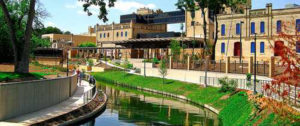San Antonio Gets the Scoop on First Commercial Biogas from Municipal Sewage
By Tina Casey
Leave it to larger-than-life Texas to lead the U.S. into a new energy future. While the state is most closely associated with oil, it has also been an early pioneer of wind power, and is beginning to embrace solar energy along with armloads of new green jobs. Now the San Antonio Water System has set the national bar high in the sewage-to-biogas field, by becoming the first water district to hook a biogas facility up to a commercial gas pipeline.
Biogas from Sewage
Methane gas, a powerful greenhouse gas, is a natural byproduct of the sewage treatment process. In conventional treatment plant operations, the general practice has been to simply burn it off. More recently, some treatment plants have installed equipment to capture the gas and use it as a power source, which significantly lowers the release of greenhouse emissions. One notable example is in Washington State, where new biogas equipment is being installed in combination with an efficiency overhaul, with the resulting savings enough to power about 210 homes annually.
Recycling Biogas On Site
Other large-scale facilities that manage animal waste are also installing biogas facilities. The advantages are many. Dairy farmers, for example, can use biogas equipment to lower utility costs, reduce waste disposal costs, and grow their business without running afoul of environmental protection regulations. The U.S. Department of Agriculture has become a key mover of this trend through its AgStar biogas program. Biogas recovery at food processing plants can also help cut utility costs, and help large-scale processors avoid millions in fines due to improper waste disposal practices.
The San Antonio Water System and Biogas Recovery
The new biogas system was installed in partnership with Ameresco, Inc. at the Dos Rios Water Recycling Center. Biogas captured at the facility is sold commercially through a nearby gas pipeline for an estimated $200,000 annually, which will help manage the cost of the treatment facilities. Biogas is just one-third of the Dos Rios “trifecta” as Ameresco calls it. Another component is biosolids, which just as in agricultural operations can be used as fertilizer. Third is the high quality water that comes out of modern sewage treatment plants, which in the case of Dos Rios is good enough to use for irrigating San Antonio’s famous Riverwalk as well as recreation facilities, parks and commercial properties.
From Clean Technica (opens in new window)
Contacts:
Ameresco: CarolAnn Hibbard, 508-661-2264, [email protected]


